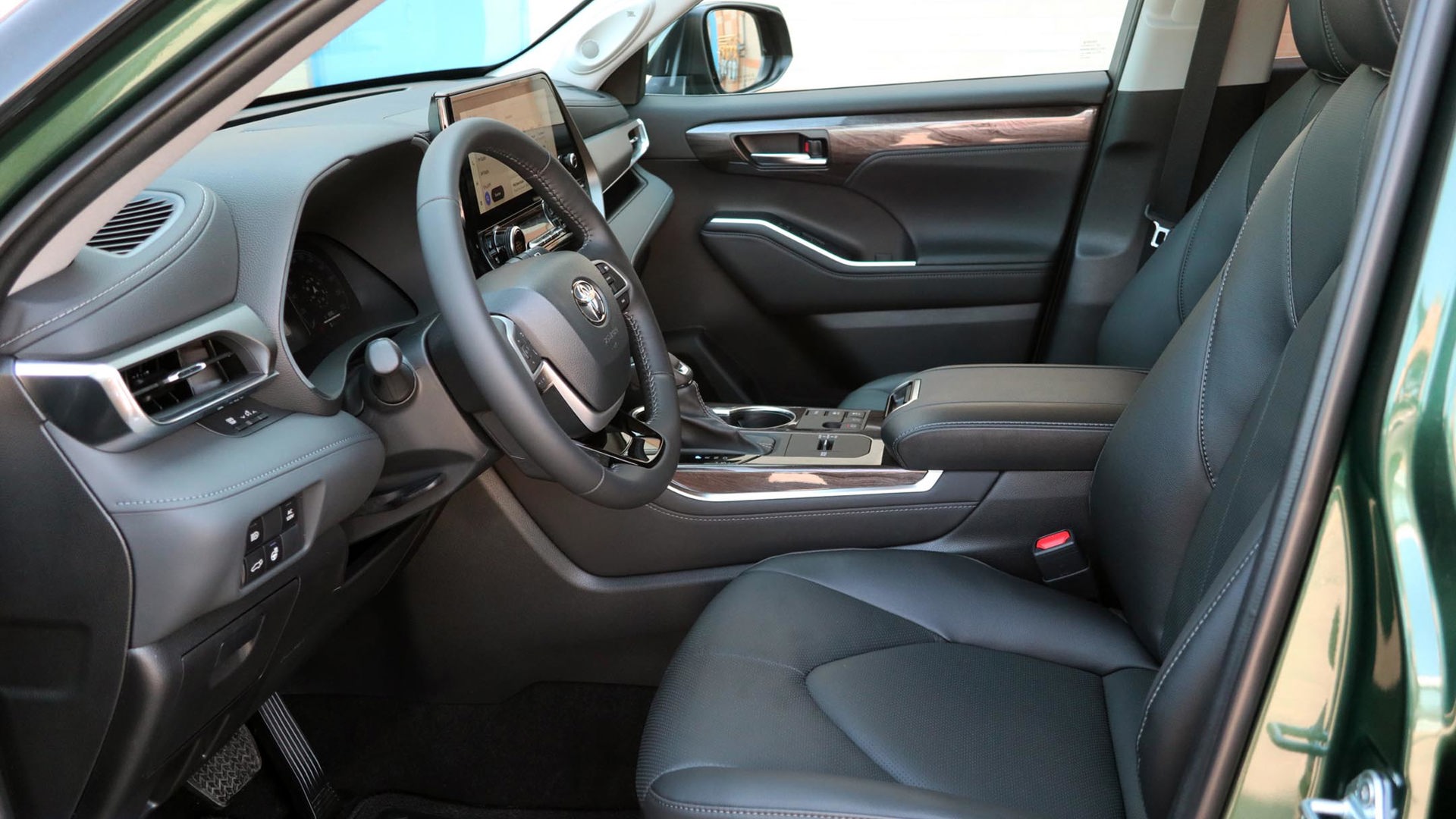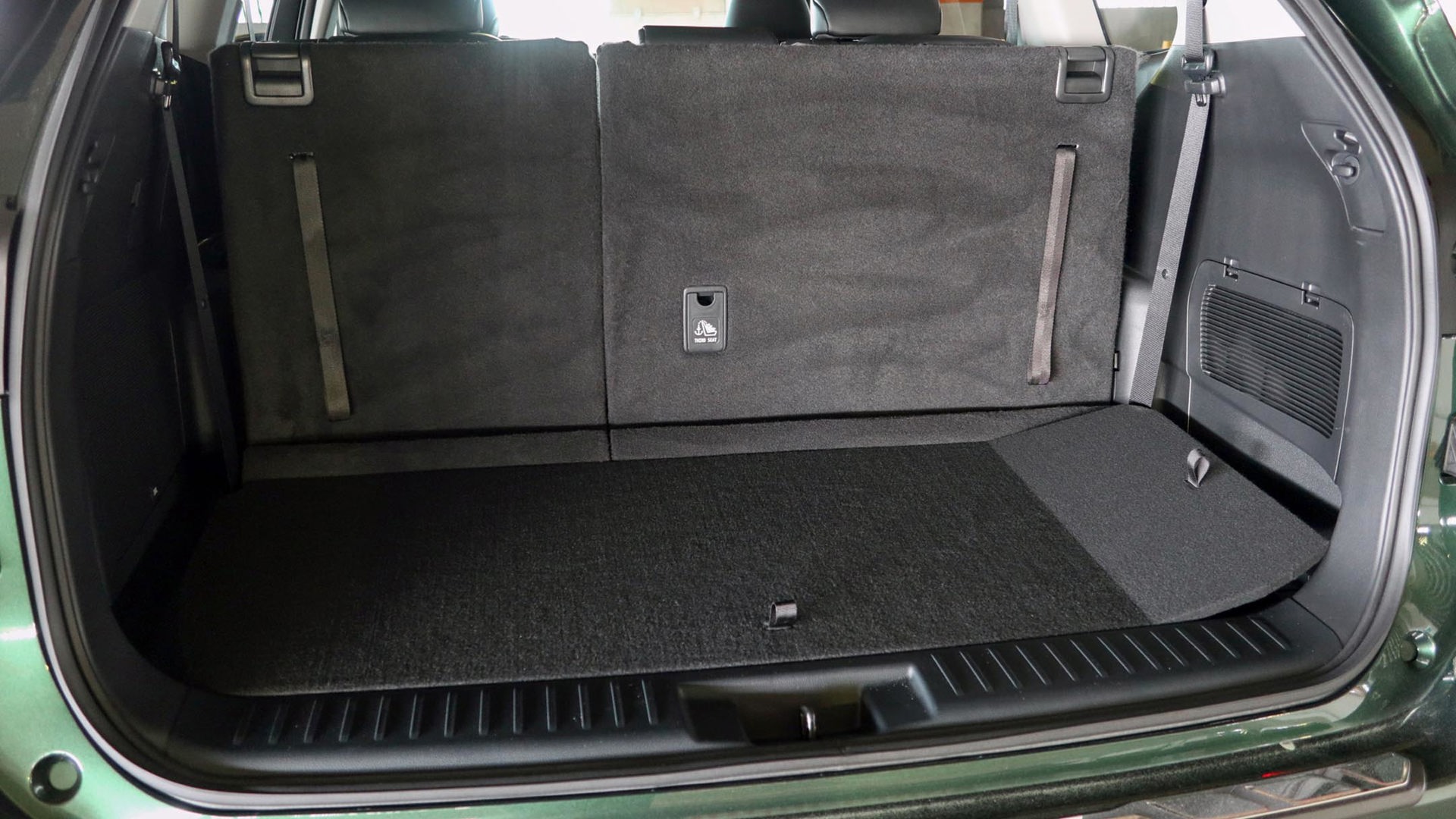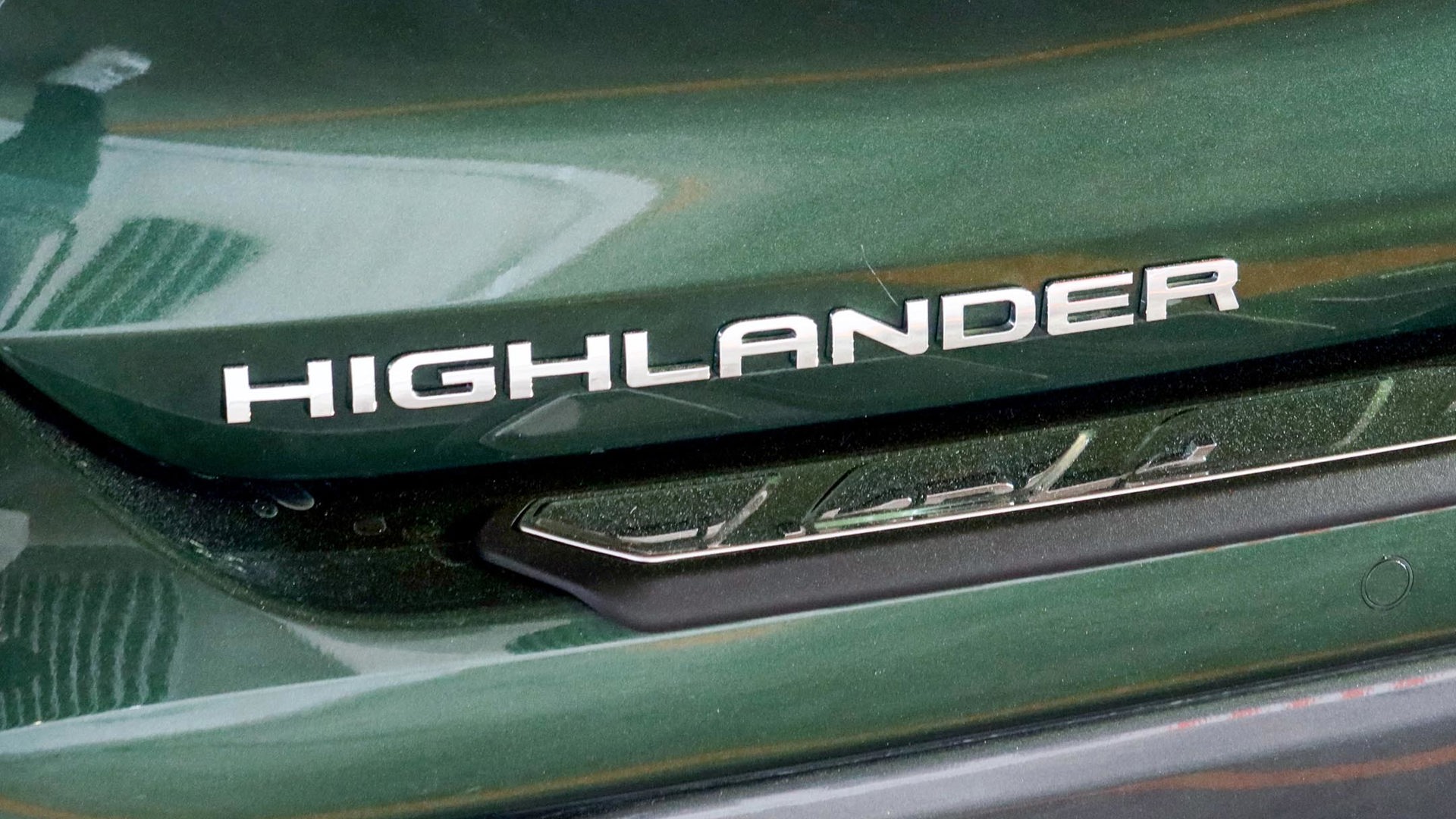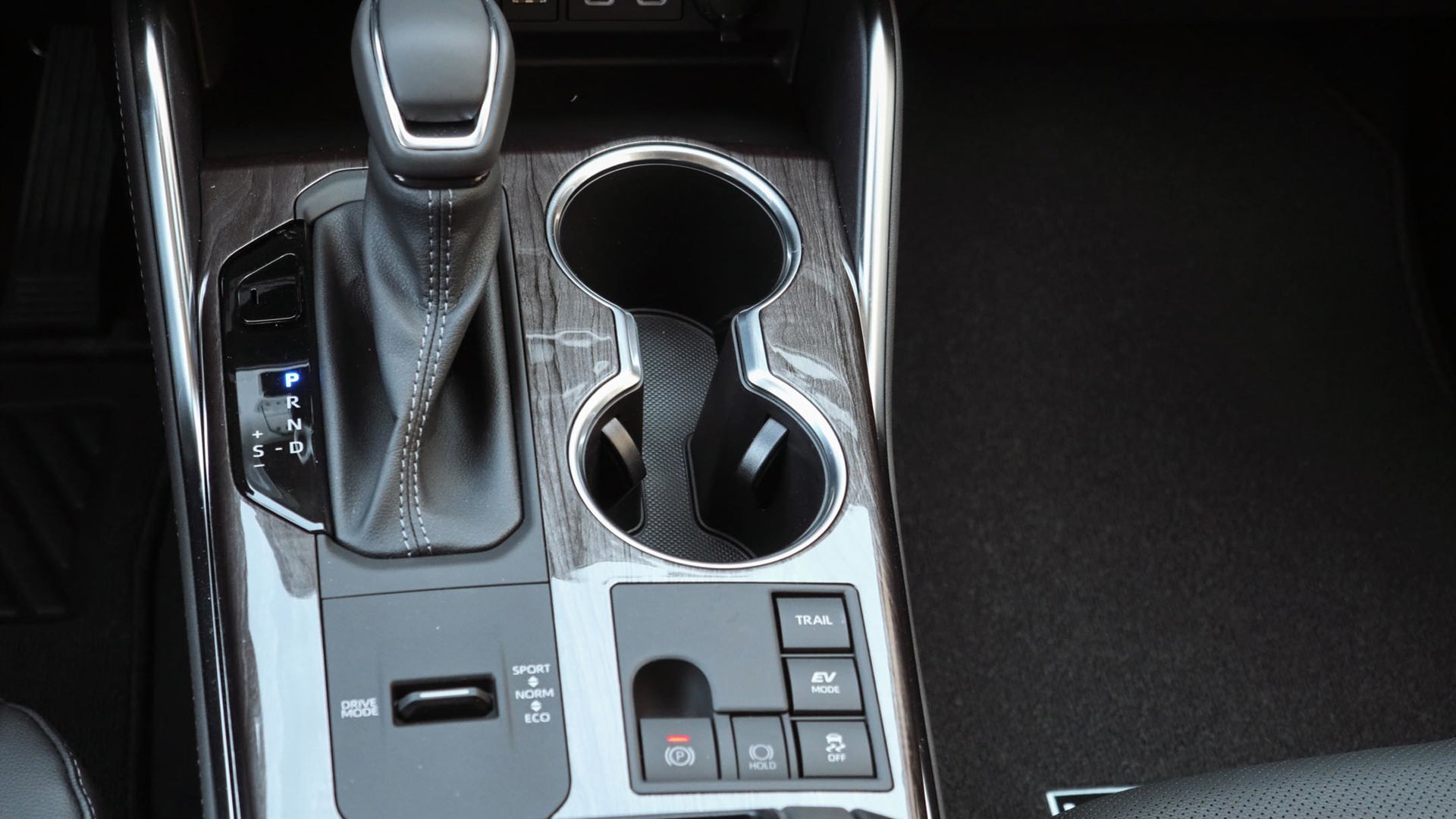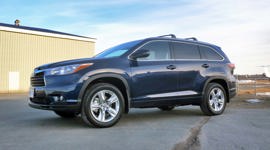 AutoTrader SCORE
AutoTrader SCORE
-
STYLING8/10
-
Safety9/10
-
PRACTICALITY8/10
-
USER-FRIENDLINESS9/10
-
FEATURES9/10
-
POWER8/10
-
COMFORT8/10
-
DRIVING FEEL8/10
-
FUEL ECONOMY9/10
-
VALUE8/10
While minivans still exist, the three-row SUV has generally become the household hauler of choice.
The 2023 Toyota Highlander Hybrid handles the task efficiently thanks to its gas – electric propulsion. New infotainment features this year include a 12.3-inch screen and Google-based cloud navigation in the Limited trim and up. The hybrid lineup starts with the LE at $50,080, including a non-negotiable delivery fee of $1,930; the XLE at $52,780; and my tester, the Limited, at $58,320. That trim can further be optioned with a Platinum package at $59,980.
Styling: 8/10
The Highlander is handsome enough but bland, and with an odd bulging body line that starts on the front door and slides up over the rear wheel well. The LE and XLE ride on 18-inch alloy wheels, while the Limited has 20-inch rims.
The cabin is far more interesting, with the centre screen integrated into a panel that splits the dash’s upper and lower sections. Metallic accents brighten up the interior, and the soft-touch materials give it a premium look and feel.
Safety: 9/10
The Highlander receives the highest five-star crash-test rating from the United States National Highway Traffic Safety Administration (NHTSA), as well as the highest Top Safety Pick+ from the Insurance Institute for Highway Safety (IIHS). However, it scored “Marginal” in the latter organization’s updated test for moderate front overlap crash, which now assesses injury risk to a rear-seat passenger, but which won’t be a factor in determining the awards until 2024.
All trims include standard blind-spot monitoring with rear cross-traffic alert, emergency front braking with pedestrian and cyclist detection and left-turn intersection support, adaptive cruise control, lane-keep assist, lane tracing, automatic high-beam headlights, and steering assist for pedestrian and cyclist avoidance, along with the back-up camera that’s mandatory on all new vehicles. The Limited further adds rear cross-traffic braking.
Features: 9/10
The Highlander Hybrid comes well-equipped, as you’d expect for the price. All trims include a power tailgate, power driver’s seat, heated front seats, LED head- and fog lights, tri-zone climate control, and the new infotainment system with wireless Apple CarPlay and Android Auto. The XLE further adds a power sunroof, heated steering wheel, faux-leather upholstery, power passenger seat, and auto-dimming rearview mirror.
Moving up to the Limited adds ventilated front seats with driver’s-side memory, leather-trim upholstery, a panoramic sunroof, hands-free tailgate, 11-speaker premium audio, and two 110-volt outlets. The 12.3-inch touchscreen comes with a three-year package subscription that includes Google-based cloud navigation and real-time traffic. Meanwhile, the Platinum package then adds heated second-row seats, rain-sensing wipers, bird’s-eye view cameras, and a head-up display.
User-Friendliness: 9/10
Despite the updated screen and system, Toyota hasn’t stuffed all the controls into the infotainment system but has retained buttons and dials, which is less distracting than searching through menus and trying to accurately tap an icon. That includes the heated and ventilated seats, the rear temperature controls – which can be operated by those in the front seats, if they don’t want younger second-row passengers messing with the controls available to them at the back of the console – and the drive modes. The gear selector is conventional, rather than an electronic one. The touchscreen is also easy to operate, with simple menus and icons, and with the Limited’s package, saying, “Hey, Google” wakes up the virtual assistant who’s ready to listen for your request.
Practicality: 8/10
The LE and XLE have a second-row bench for eight-passenger seating in total, while the Limited has two captain’s chairs – which can be optioned on the XLE – for seven seats in all. A benefit to those chairs is third-row access; rather than push one forward and squeeze through the small opening, you can get in and then step between them to the last row.
Cargo capacity is mid-range for the segment, but the tailgate opening is low and wide, and it’s easy to pack items in. Small-item storage is good up front, too, with storage cubbies in the console and under the centre screen. The console box has a sliding lid, so a passenger using it as an armrest doesn’t have to move as with a lift-up lid. Towing capacity is 1,587 kg (3,500 lb).
Comfort: 8/10
The Highlander Hybrid is roomy in the first- and second rows, and the seats are supportive and comfortable. Third-row passengers won’t be quite as happy; legroom is tight and the seats are flat, and best for children or adults on short trips. But the ride is smooth and the cabin is quiet. Meanwhile, those looking for a bigger option with the same powertrain should check out both the Grand Highlander that was recently introduced, as well as the stylish Sienna.
Power: 8/10
The Highlander Hybrid uses a 2.5L four-cylinder engine that, on its own, makes 186 hp and 175 lb-ft of torque. It’s combined with twin electric motor-generators up front, and the combined system creates 243 hp, which goes to the front wheels through an automatic continuously-variable transmission (CVT). All trims feature all-wheel drive (AWD), using an additional electric motor that powers the rear wheels fuel-free when needed for extra traction. It’s peppy from a stop and with enough strength for highway passing.
The hybrid system automatically switches between gasoline, electricity, or a combination, depending on driving conditions, and the transition is smooth and seamless. The battery recharges through regenerative braking, capturing energy otherwise lost while slowing down, and the vehicle doesn’t get plugged in.
Driving Feel: 8/10
The Highlander Hybrid behaves as expected for the segment. The steering is responsive and light; it keeps its composure on rougher road surfaces, with only the hardest bumps making their way into the cabin; it’s confident and well-planted on the highway; and while it’s obviously not meant for sporty driving, it follows curves without any fuss. Hybrids can sometimes have harsh or grabby braking feel, due to that battery-charging regenerative system, but the Highlander’s brake pedal feel is smooth.
The console includes an “EV” button that prioritizes electric driving, but don’t expect an extended period on electricity only. It’s meant to keep the Highlander on its battery alone at low speeds, but the system does that anyway, and even slightly too much throttle will turn the EV mode off. Oddly, I tried using it in a parking garage, but it wouldn’t activate because the hybrid battery was apparently too low (which can happen if you’ve been driving at lower speeds for a while without the brakes recharging it; the system will rely more on the engine until there’s enough battery power). Even so, the system automatically cruised through the garage on its battery alone, reinforcing my opinion that the EV-mode button is a waste of console space.
Fuel Economy: 9/10
The Highlander Hybrid is rated by Natural Resources Canada (NRCan) at 6.6 L/100 km in the city, 6.8 on the highway, and 6.7 in combined driving. I came in higher at 8.5 L/100 km in my week with it, which was heavy on highway driving where it can’t use battery power as much. It takes regular-grade gasoline. In contrast, the gas-only Highlander rates 9.9 L/100 km combined.
It doesn’t have much competition in the three-row hybrid category, and sits mid-pack among its rivals’ ratings, where the slightly smaller Kia Sorento Hybrid is marginally better at 6.6 combined, but the Ford Explorer Hybrid is much more powerful and subsequently much thirstier at 9.6 L/100 km.
Value: 8/10
The Highlander Hybrid runs from $50,080 for the LE to $59,980 for the Platinum. To move up to the hybrid from the gas-only Highlander, which gets a new turbocharged four-cylinder engine in place of its previous V6, is an extra $2,500 in each trim.
Among three-row rivals, it’s pricier than the Kia Sorento Hybrid, which starts at $40,844 (in its sole hybrid-only trim; all others are plug-in hybrids) but well under the Ford Explorer Hybrid, which comes only in Limited trim at $62,025 (all prices including destination).
The Verdict
The 2023 Toyota Highlander Hybrid is now joined by a larger sibling of a similar name that offers more third-row legroom, but it’ll be at least $3,000 more. The Sienna minivan is also an excellent family choice and now comes exclusively as a hybrid. But if an SUV is the plan, the Highlander offers a comfortable ride and lots of features. For many, the $2,500 premium of stepping up to the hybrid’s smooth operation and fuel economy, while not insubstantial, will be a worthwhile investment.
| Engine Displacement | 2.5L |
|---|---|
| Engine Cylinders | I4 |
| Peak Horsepower | 186 hp @ 6,000 rpm (gas engine), 243 hp (hybrid net) |
| Peak Torque | 175 lb-ft @ 4,400 rpm |
| Fuel Economy | 6.6 / 6.8 / 6.7 L/100 km cty/hwy/cmb |
| Cargo Space | 453 / 1,370 / 2,387 L behind 3rd/2nd/1st row |
| Model Tested | 2023 Toyota Highlander Hybrid Limited |
| Base Price | $56,390 |
| A/C Tax | $100 |
| Destination Fee | $1,930 |
| Price as Tested | $58,420 |
|
Optional Equipment
None
|
|




